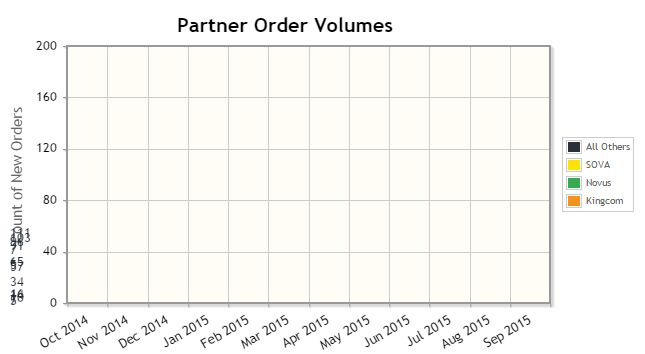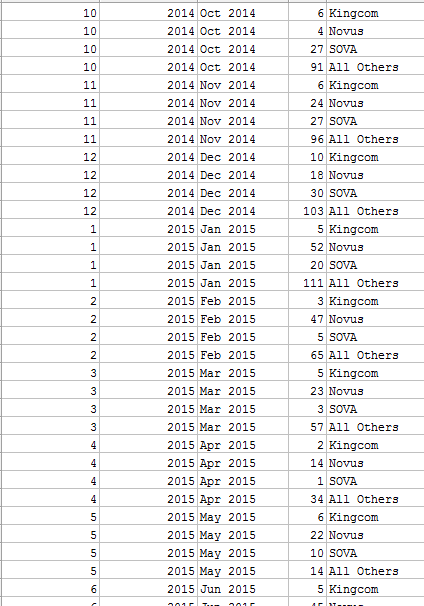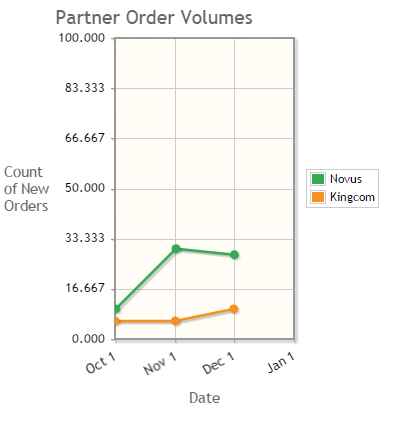I'm using jqPlot to generate a stacked bar chart based on data from a web method.
The chart renders successfully, but is blank. When I set the pointLabels to 'true', they appear in a jumble to the left of the chart. I'm guessing the stacked bars are also being rendered off-chart, but I don't understand why.
Could some one please explain how to fix this?
Here is the webmethod:
[WebMethod]
[ScriptMethod(ResponseFormat = ResponseFormat.Json)]
public List<dataPoint> getPartnerOrderVolumes()
{
List<dataPoint> p = new List<dataPoint>();
DataTable dt = new DataTable();
chart jep = new chart(5);
foreach (chartData cd in jep.lstChartData)
{
dt = cd.GetData();
}
if (dt.Rows.Count > 0)
{
foreach (DataRow row in dt.Rows)
{
dataPoint dp = new dataPoint();
dp.x1Value = row[2].ToString();
dp.y1Value = row[3].ToString();
dp.y2Value = row[4].ToString();
p.Add(dp);
}
}
return p;
}
Here is the dataPoint class used by the web method:
public class dataPoint
{
public string x1Value { get; set; }
public string y1Value { get; set; }
public string x2Value { get; set; }
public string y2Value { get; set; }
public string x3Value { get; set; }
public string y3Value { get; set; }
public string x4Value { get; set; }
public string y4Value { get; set; }
}
Here an example of the data it pulls from the database:
Here is the javascript:
function OnSuccess_(response) {
var aData = response.d;
var types = [];
var arrType = [];
var arr = [];
// find distinct types (partners)
for (i = 0; i < aData.length; i++) {
if (types.indexOf(aData[i].y2Value) === -1) {
types.push(aData[i].y2Value);
}
}
// generate array containing arrays of each type
for (i = 0; i < types.length; i++)
{
var filtered = aData.filter(function (el) {
return el.y2Value == types[i];
});
arrType.length = 0;
$.map(filtered, function (item, index) {
var j = [item.x1Value, item.y1Value];
arrType.push(j);
});
arr.push(arrType);
}
$.jqplot.config.enablePlugins = true;
plot1 = $.jqplot('chart5', arr, {
title: 'Partner Order Volumes',
// Only animate if we're not using excanvas (not in IE 7 or IE 8)..
animate: !$.jqplot.use_excanvas,
stackSeries: true,
seriesColors: ['#F7911E', '#32AB52', '#FFE200', '#29303A'],
seriesDefaults: {
shadow: true,
pointLabels: { show: true },
renderer: $.jqplot.BarRenderer,
rendererOptions: {
varyBarColor: true,
animation: { speed: 2000 },
barDirection: 'vertical'
}
},
legend: {
show: true,
location: 'e',
placement: 'outside',
labels: types
},
axesDefaults: {
labelRenderer: $.jqplot.CanvasAxisLabelRenderer,
tickRenderer: $.jqplot.CanvasAxisTickRenderer,
tickOptions: { fontSize: '10pt', textColor: '#000000' }
},
axes: {
xaxis: {
renderer: $.jqplot.CategoryAxisRenderer,
tickOptions: { angle: -30 }
},
yaxis: {
label: 'Count of New Orders',
min: 0,
max: 200
}
},
highlighter: { show: false }
});
}
function OnErrorCall_(response) {
alert("Whoops something went wrong!");
}
});



